#global nuclear disarmament
Text



we were fated to pretend
14 notes
·
View notes
Text
US conducts nuclear test in Nevada hours after Russia scraps ratification of global nuclear disarmament pact
youtube
0 notes
Text
youtube
#youtube#militarytraining#2024#Strategic Stability#Risk Reduction#Western Hemisphere#Arms Control#Geopolitics#Conflict Resolution#International Relations#Diplomacy#Nuclear#Foreign Policy#Global Affairs#Peacebuilding#Security#South America#April 24#Nuclear Disarmament#Nuclear Weapons#Defense#North America#Nuclear Proliferation.
0 notes
Text
i hate the oppenheimer movie simply for the fact its making people sympathize with fucking oppenheimer and the people who created man made horrors beyond comprehension
#some of the arguments are disgusting and extremely online#he did an imperialism and he’s bad cope and seethe#perspectives of japanese and navajo people totally absent from those posts#someone points that op is ALWAYS usamerican and gets called a bigot#hell world#we don’t need to nuance oppenheimer we need nuclear disarmament now. fuck oppenheimer focus on how this affects people globally NOW#focus on the aftermath NOW#stop writing fanfic that you think explains his motivations. it. does. not. matter. now#oppenheimer
1 note
·
View note
Text
youtube
There is a golden spike hiding in a rock face outside the village of Moffat in Scotland that marks the end of the Ordovician, denoted by the appearance of these graptolite survivors—Akidograptus ascensus and Parakidograptus acuminatus, to give them their scientific names. It's not a real golden spike but a line of darker shale and a marker of these graptolites' significance as what's called an index fossil: Wherever such a fossil is found a geologist can be sure those rocks are of a certain age.
We have found the perfect marker for the Anthropocene, or the new epoch of humans, so dubbed for Homo sapiens’s world-changing impacts. It's a rather precise start date, thanks to some unusual isotopes: July 16, 1945, at 5:29 in the predawn New Mexico desert. That's when U.S. scientists exploded the world's first atomic bomb and when the human-induced radioactive isotope clock started ticking.
The three isotopes in question are cesium 137 and plutonium 239 and 240, which will take millennia or more to decay. There are no known natural sources of cesium 137. As a result of the subsequent detonations of hundreds of such weapons around the globe, there will be plenty of these isotopes still around far into the future. Like the meteorite that helped end the Cretaceous period about 65 million years ago, and possibly the reign of the dinosaurs as well, the nuclear detonation may mark for future geologists a turning point in Earth's history.
#history#geology#geological ages#anthropocene#age of humans#atomic testing#global impacts#fallout#radioactive isotopes#prevalence of cancers#two largest nuclear arsenals involed in proxy war in ukraine#still possiblity of atomic exchange#people forget#no to nukes#nuclear disarmament is still important
0 notes
Text
Strengthening partnerships for disarmanent.




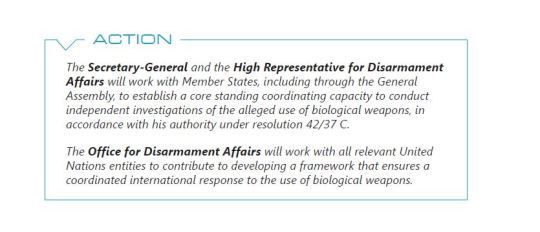









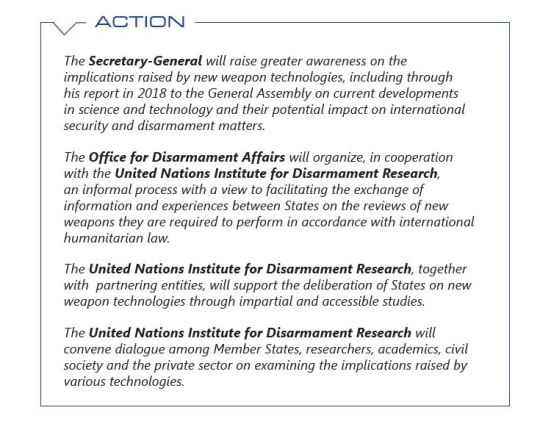

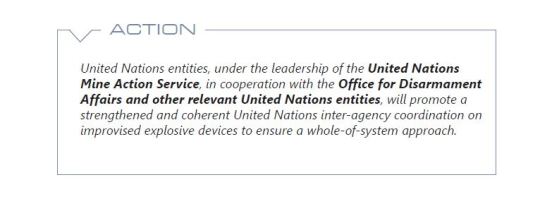


Weapons of mass destruction, in particular nuclear weapons, continue to be of primary concern, owing to their destructive power and the threat that they pose to humanity. The excessive accumulation in conventional weapons and the illicit trade in small arms and light weapons jeopardizes international peace and security and sustainable development, while the use of explosive weapons in populated areas is seriously endangering civilians. New and emerging weapon technologies, such as autonomous weapons, pose a challenge to global security and have received increased attention from the international community in recent years
#biological weapons#Arms#arms control#Disarmament#Non Proliferation#Amunition#Chemical weapon#nuclear weapons#cybersecurity services#explosive weapons#small arms#stokpiles#Weapons of mass destruction#peace and security#take action#challenge to global security
0 notes
Text
I like reallifelore videos but God damn does he love sucking nato's dick every chance he gets
#if scotland became independent and nuetral with the goal of nuclear disarmament that would be a postive for the world dipshit#not everyone needs to weigh in on global conflict#and less nukes in the world is better
0 notes
Text
I still can't get over the Israeli defense minister saying: "what we are doing in Gaza we can do in Beirut."
The sheer gravity of this statement alone.
Israel has set dangerous precedents with nuclear weapons, and they're already threatening millions more Lebanese civilians living in Beirut. The real threat here is ISRAEL.
Over a 100 countries at the UN have demanded a ceasefire, but a handful of counties refuse to budge:
•Israel and the US (they're in the same line because apparently their governments are beyond interconnected)
•Canada
•Hungary
•Marshall Islands
•Micronesia
•Nauru
I'm adding GLOBAL DEMILITARIZATION and GLOBAL NUCLEAR DISARMAMENT to my ceasefire demands because enough is enough of these war mongering, genocidal, greedy and grotesque officials in government.
#feminist#feminism#israel is an apartheid state#palestine#freepalastine🇵🇸#free gaza#social justice#free palestine#israel#lebanon#beirut#gazaunderfire#gaza strikes#warmongers#israel is committing genocide#war crimes
31 notes
·
View notes
Text
'If you’ve ever read an interview with the Irish actor Cillian Murphy, you might think him shy, irritable, or even neurotic. Journalists love to write about how closed-off he is, that if you ask him anything too personal he’ll shut down and give one-line answers. This makes their job very hard, they say. But what those interviews don’t tell you, is that if you let Murphy talk about a subject that he actually wants to talk about – such as his epic new film about the father of the atomic bomb J. Robert Oppenheimer – he’ll go on for ages. And he’ll be very open and interesting while he’s doing it. He might even make a joke.
He does this when NME meets him at a posh hotel in Soho. We’ve just walked into the room. Murphy is sat down, wearing a black v-neck jumper over a white t-shirt, black trousers and a pair of very pointy Chelsea boots. He seems relaxed, and greets us with a cheery “hello!���. Then he recognises the thick paperback tucked under our arm as a copy of American Prometheus, the Pulitzer Prize-winning biography from which Oppenheimer is adapted. We’d intended to read a quote from the book later but Murphy cuts in on our explanation. “No, you brought it in here to be pretentious,” he grins. “Would you like me to sign it for you?”
There are people who would sell their grandmas for a mere glimpse of Murphy, let alone an autograph. He’s been dogged by screaming fans since the early days of his career – when he broke out as often-shirtless apocalypse survivor Jim in Danny Boyle’s 2002 horror hit 28 Days Later. Brummie gangster series Peaky Blinders made him a global star, but his most famous film roles are notable because they’ve often come from collaborations with the same director. Christopher Nolan’s sci-fi blockbuster Inception, war thriller Dunkirk and his Batman trilogy all featured Murphy as the supporting curio – a side character that pops up every so often to steal your attention from the main protagonist. But in Oppenheimer, the duo’s latest creative partnership, he finally is the main character.
And he’s a good one too. Oppenheimer was an American scientist who made vital discoveries in quantum physics during the 1920s and ‘30s, going on to oversee the creation of the atomic bomb for the US Government – two of which were dropped on Japanese cities Hiroshima and Nagasaki in 1945, killing an estimated 220,000 people. Oppenheimer spent the rest of his life campaigning for disarmament, appalled at the weapon (his preferred term was “gadget”) he had helped to give the world. He also drank heavily and had a reputation as a womaniser, despite being quiet and sometimes socially awkward. Murphy calls him “contradictory” and “complex”, which is like saying Suella Braverman doesn’t like immigrants. “I do think that he believed it would be the weapon to end all wars,” Murphy continues, attempting to explain how a left-leaning humanitarian could spend two years perfecting the ultimate killing machine. “He thought that [having the bomb] would motivate countries to form a sort of nuclear world governance.” Murphy pauses. “He was naive.”
Was that naivety a choice though? Oppenheimer had an explosive ego, once attempting to poison a university professor who chastised him when he was a student. Could his desire to achieve such as historic breakthrough have led him to ignore his own better judgement?
“That’s an interesting take,” says Murphy. He runs his hands through his hair, which is styled into wavy curtains. He does this a lot when thinking a question over. “Chris used this amazing phrase. We were talking about Oppenheimer’s arc and he said, ‘You know, he’s dancing between the raindrops morally.’ That unlocked something in my mind when I was preparing.”
To play the role of Oppenheimer, Murphy went very deep. He read the Bhagavad Gita – a 700-page Hindu religious text that the physicist famously quoted from (“Now I am become Death, the destroyer of worlds.”) Then he started “skipping meals” in an effort to slim down to Oppenheimer’s rail-thin frame. During the actual shoot, Murphy smoked so many fake cigarettes that he worried it harmed his health. “They can’t be good for you,” he told The Guardian. Oppenheimer himself died of throat cancer in 1967.
On top of the physical strain, Murphy delved into some pretty dark emotional places. He had six months to research before filming began in February 2022, and during the 67-day production he often worked 18-hour days. War, genocide and the nuclear holocaust are unpleasant to think about at the best of times, never mind your every waking moment. It must have been brutal.
“You always have to take a holiday after a job,” he concedes, as though being a Hollywood actor is no different from plumbing toilets. “It’s not because… as some journalists like to think, you’re a method actor or whatever. It’s because you give so much time to the job and then suddenly you stop. You have all this displaced energy, you know, so you kind of don’t know what to do with yourself… But I’m a very easygoing sort of person. It doesn’t weigh me down.”
We suspect Murphy isn’t being entirely truthful here. Such is the intensity of his performance – all simmering discontent and wide-eyed panic attacks – that it’s difficult to believe he just shook the weight of global armageddon off each night before climbing into bed. Emily Blunt, who plays Oppenheimer’s wife Kitty in the film, has said Murphy regularly skipped cast dinners because of the “monumental” pressure he felt. “Of course he didn’t want to [eat] with us,” she told People magazine. Matt Damon, brilliant as mustachioed military boss General Groves, agreed: “His brain was just too full.” When we push Murphy on the subject, he reveals a little more. “I didn’t go out much. I didn’t socialise much, mainly because of the amount of work I had to do… I became so immersed in the role.”
To make the experience yet more profound, cameras rolled only “a couple of days” before Russia invaded Ukraine. The West united to impose stringent economic sanctions on Vladimir Putin and his people. The value of the Ruble plummeted, Russian billionaires were booted out of London and Moscow became a cultural ghost town with the likes of Green Day and Iron Maiden cancelling gigs. Putin’s response? To start lining up tactical nukes along his borders. Armageddon seemed closer than at any moment since the Cold War. Murphy (and his castmates) felt the heat. “It was everywhere, and we were fully aware of that,” he says. “The threat [of nuclear war] has escalated and receded over the years since 1945… and now it’s back. It’s always there, this Sword Of Damocles that is hanging over us.”
Murphy, 47, knows what it’s like to exist against the backdrop of conflict. He grew up during the Troubles in late 1970s and ‘80s Cork, Ireland, where reports of sectarian violence in the north often dominated the news. His mum was a French teacher and his dad worked for the civil service. As a teenager, he was obsessed with music. He read NME and loved Frank Zappa and The Beatles. To illustrate his fandom, he tells us about a trip he took to Liverpool, later in life, to see the legendary Cavern Club, where the mop tops first cut their teeth on stage. “I walked down to [the street where the Cavern Club is supposed to be],” he says, “and it wasn’t there. It was somewhere over there!” He gesticulates with his hands. “It’s not the real Cavern. It’s just a mock-up!”
Inspired by John, Paul, George and Ringo, Murphy and his brother formed a band: The Sons of Mr Green Genes, named after a Zappa tune from the avant garde groover’s 1969 album ‘Hot Rats’. The songs were similarly experimental, filled with “wacky lyrics and endless guitar solos”. Eventually, an indie label based in London, Acid Jazz, put a five-album deal on the table. He and his brother turned it down, citing reasons of artistic independence, but for a while rock and roll appeared more inviting than the movies.
Murphy is often disparaging about his songs to journalists, but they must have been doing something right. He’s also self-deprecating when we bring up the underrated 2002 short film Watchmen, which he co-wrote with BAFTA-winner Paloma Baeza – his only attempt at a screenplay. “I just never thought that I was good enough really,” he says. “It’s why I haven’t, you know, pursued the music either… I like to do one thing quite well.” He adds that it’s unlikely this will change in the future.
Murphy will be far too busy to write songs or screenplays for a while anyway. The first reviews for Oppenheimer are out, and some critics have him earmarked for an Oscar. He’ll charm his way through awards season no doubt, just as he does at the Paris premiere the night before our interview. Done up in a black suit with mustard shirt and matching oversized tie, he looks a bit like the handsome English teacher your best mate had a crush on. Walking the red carpet, he is happy to answer questions, speaking at length about Nolan’s genius and the “amazing” reaction to Oppenheimer so far. You can tell he’s enjoying himself.
Murphy’s not on duty tonight though, with London’s premiere scheduled for the day after our chat. Then he’ll be waiting to get on with his next gig, the dark indie drama Small Things Like These, adapted from Claire Keegan’s bestselling 2021 title, in which he’ll take the lead role. Following his breakthrough blockbuster with a low-key Irish drama is typically understated of Murphy, so not unexpected. More box office projects loom on the horizon – a standalone Peaky Blinders movie and the long-awaited horror threequel 28 Months Later – but he says he has “no new information” on either.
It’s difficult to say what Oppenheimer means for Murphy. He is a household name in the UK and Ireland, but less so in the States, where some still see him as a ‘TV actor’. In a recent interview to promote the film, Robert Downey Jr. talked of Murphy’s life “changing” after Oppenheimer, as if he’s a fresh actor on the scene. In a sense, Downey Jr. is right. This is Murphy’s first lead role in a sure-fire smash. And the parts he gets offered now may be a bit starrier. But don’t expect to see him in spandex on a Marvel soundstage anytime soon.
“I like unknowable, ambiguous, kind of enigmatic [characters],” he says. “To me that’s human life: the knotty, weird grey areas… A good man’s life is wholly uninteresting.”'
#Cillian Murphy#Oppenheimer#Christopher Nolan#Robert Downey Jr#Peaky Blinders#Small Things Like These#Claire Keegan#American Prometheus#28 Days Later#Danny Boyle#Inception#Dunkirk#Batman Trilogy#Bhagavad Gita#Emily Blunt#Kitty#Matt Damon#The Sons of Mr. Green Genes#Watchmen
58 notes
·
View notes
Text
two positions on effective nuclear power advocacy
1. everytime there's an attempt to build a nuclear plant in india there are mass local protests which get locked into cycles of state repression due to fear of meltdowns. that's actually also the case with building dams (narmada bachao), large mining projects (vedanta) and expansion of coal plants (thermal power plants in assam/tamil nadu.) dam opposition is actually the most powerful environmental force in the country.
people are right to believe that they will be uprooted from their lives and that they will not be adequately protected in the case of failures which is borne out by the the bhopal gas tragedy or sterlite gas leaks. nobody wants to live near these plants. so inevitably it is the world's most marginalised people who end up living near them. look at the data on land conflict watch regarding industrial land use and acquisition for power.
outside the comfortably stupid german green party caricature there are actually people with serious concerns about nuclear power. long term investments and public trust can only occur when energy prices decrease and plants operate reasonably safely. prices of nuclear hover around ₹4 per unit while solar is ₹2 per unit in india. and it is a lie to pretend global nuclear retrenchment happened due to a conspiracy by oil/gas instead of the extremely expensive price of failure at fukushima (200 billion usd or so.) westinghouse went broke. pretending nuclear waste is the concern and not meltdowns is missing the forest for the trees.
2. i think we need to recognise the way the Non Proliferation Treaties choke civilian nuclear power while not making any commitment to long term disarmament in nuclear states rather than berating people with misgivings about meltdowns. rn, nuclear security for me and not for thee is its basic principle. the Nuclear Suppliers Group has not approved membership for india because it remains a useful tool of superpower gamesmanship.
lack of nuclear fuel means most existing nuclear power plants in india run at 60% capacity because we don't have that much uranium and have to import it and widely available thorium requires breeding which is technologically and economically infeasible. technology sharing is obviously very difficult when you're not in the NSG.
the US betrayal of iran after their deal was struck is the other obvious roadblock to building nuclear capacity in the third world. restricting nuclear tech is another way that imperial noose seeks to maintain control of states trying to unseat themselves from domination. it is not actually a surprise that north korea continues to pursue a weapons programme because deterrence works. and ukraine, of the three countries that disarmed because of the NPT is currently being invaded. you either subsume to China/Russia/US for defence or you just don't get to have nuclear energy which is not the position of a world that wants nuclear energy.
#imperialism#nuclear power#controversial opinion held weakly but argued strongly for interestingness#left discourse#long post
90 notes
·
View notes
Text
Project Blue Beam

Nasa has been working on aircraft that are real, but will become a part of the Global Holographic Alien Invasion/Light show. This may also include a staged 2nd coming of historical fugures; such as Jesus or Mohammed or Krishna.
BLUE BEAM Has 4 Steps:
Step 1
The first step concerns the breakdown of all archaeological knowledge. It deals with staging earthquakes at certain precise locations around the planet where supposed new "discoveries" will finally explain that the meanings of the basic doctrines of all the world`s major religions are wrong. This falsification will be used to make the population believe that all religious doctrine has been misunderstood and misinterpreted. For example, in the entertainment/movie industry, a falsification started with the film(s) 2001: A Space Odyssey, the TV-series Star Trek, the Star Wars films, and E.T., all of which deal with space invasion and protection. Another movie example is Jurassic Park which was released to push the Theory of Evolution.
Step 2
The second step deals with the gigantic space show: 3D optical holograms and sounds, laser projections of multiple holographic images in different parts of the world, each receiving a different image, according to its predetermined original national religious faith. This new "god" image will talk in all languages. As an example, the Soviets have manufactured the advanced computers and have programmed them with the Minute Psychological Particles based upon their studies of the anatomy and biology of the human body, as well as their studies on the anatomy, chemistry and electricity of the human brain. These computers have also been fed with the different languages of the world.
Step 3
The third step deals with telepathic electronic two-way communication, where ELF(Extra Low Frequency), VLF (Very Low Frequency), and LF (Low Frequency) waves will reach the people of the Earth through the insides of their brains, making each person believe that his own God is speaking to him from within his own soul. Such rays, from satellites, are fed from the memory of computers that store much data about the human being and his languages. These rays will then interlace and interweave with the natural thinking processes to form what is called Artificial Talk.
Step 4
The fourth step involves universal supernatural manifestations using electronic means. This step contains three different orientations:
The first one is to make mankind believe that an Alien Invasion is about to occur upon every major city on the earth. This is to push each major nation into using its nuclear capability to strike back. In this manner, it would put each of these nations in a state of full disarmament before the United Nations after the false attack.
The second is to make the vast Christian population believe that a major rapture is occurring, with a simple, orchestrated, divine intervention of an alleged "good" alien force coming to save the good people from a brutal satanic attack. Its goal is to get rid of all significant opposition to the New World Order.
The third orientation is a mixture of electronic and supernatural forces. The waves or frequencies used at that time will allow supernatural forces to travel through fiber optics cable, coaxial cable, electric and telephone lines in order to penetrate all electronic equipment and appliances that will by then all have a special microchip installed. The goal of this step deals with the materialization of satanic ghosts, spectres, and poltergeists all across the globe in order to push all populations to the edge of a wave of suicide, killing and permanent psychological disorder. After that night, humanity is believed to be ready for them to enter in a "New" Messiah to re-establish peace everywhere at any cost, even at the cost of their freedom.
32 notes
·
View notes
Text
Russia withdraws from comprehensive nuclear test ban treaty
youtube
#Nuclear test Ban Treaty.#Nuclear disarmament#Testing nuclear missiles#Russia#U s a#Global nuclear disarmament.#Youtube
0 notes
Note
Hi
As you are probably aware, these are dark days for all the free people, all the people who can appreciate freedom, beauty, knowledge, progress and are struggling to improve themselves and the world. We are witnessing an unprecedented situation, something whose magnitude of importance outweighs everything else since the Second World War. People’s rights are violated, their dreams destroyed, their happiness shattered, their sovereign lands and way of life are imperiled. And yet, it’s not all about this great tragedy, because a bigger one is looming above us all. Connected with the first Chapter of Misery, now a second Chapter opens: of potential War with global consequences.
I want to tell you that you have been brave so far, and able, and willing; and you fight for your beliefs, and you try to change attitudes and social perceptions, and you struggle for equality and rights and acceptance. You have noble aspirations, and you want to see a better future.
This future is now in grave danger from something that could erase everything in minutes. Everyone is aware of the threat of Nuclear Weapons, and so far, the superpowers have been reluctant to use them, even going to the extent of signing treaties of progressive disarmament, up to a degree. For the first time in this generation, this might stop, and also, the nuclear armament is to increase, and placed in various parts of Europe, and the rest of the world. If you care for your friends, your family, your children… and even if you only care for economic benefits and financial interests, a Nuclear War Must Not Happen. Even in the case of a limited exchange of strikes, the radiation will kill thousands, and damage hundreds of thousands. A total war, as everyone knows, is not to anyone’s interests; it is madness. And yet, despite common sense, despite many forecasts by analysts and politicians, this DANGER is before Europe’s door.
If this planet matters to you in any way, if life itself still matters to you, if you Love, if you still desire to live in a world free of such a threat, now is the time to act. Speak to your friends, the local authorities, the politicians, the government everywhere; speak to them in the armed forces, in the police, the emergency services, the hospitals, raise awareness Now, and put pressure to All to Listen. Join your voice to many millions of others; and for those who don’t have a voice, living in a third world country, become their Voice and protest against Nuclear War. This is the closest we have been on the doorstep of annihilation, and if a nuclear exchange starts, it won’t stop until the protocols say so. So it’s important that it Never Starts. The future of this world is in Your Hands.
Thank you for listening.

22 notes
·
View notes
Text
Susi Newborn — one of the most skilled and effective activists in Greenpeace’s 52-year history — passed away on the last day of December 2023. She is remembered fondly by her beloved children, Brenna, Woody, and Naawie; her granddaughter Toody; by her ex-husbands, Martini Gotje and Luc Tutugoro; and by friends, colleagues, and shipmates around the world.
In 1977, when Susi arrived in Canada for her first Greenpeace action, to protect infant harp seal pups in Newfoundland, she was already something of a legend. Journalistic tradition would have me refer to her as “Newborn,” a name that rang with significance, but I can only think of her as Susi, the tough, smart activist from London.
Susi was born in London in 1950, from Argentine parents. Her mother had grown up among the Buenos Aires elite and knew famous artists such as Raul Soldi and Mexican muralist Don Sequeiros. Susi’s godmother was a founding member of the Campaign for Nuclear Disarmament (CND) in the UK, and a colleague of Bertrand Russell. Susi grew up meeting writers, philosophers, and artists.
Susi’s father was an Argentine Embassy diplomat, whom she described as “a deeply spiritual man.” He told her about meeting Mahatma Gandhi and urged her to “work for peace.” At the age of five, she stopped her father from chopping down a tree near their London home, her first ecology action, and in 1970, at the age of 20, she attended the world’s first Earth Day protest in London’s Trafalgar Square.
Argentina at the time suffered under a series of military dictators, and Susi’s father quietly opposed the Junta headed by General Alejandro Agustín Lanusse. When her father died, the tragedy radicalised her and she embarked “on a personal journey of activism.”
Hosting the film star
Susi worked for Friends of the Earth in London for two years, and in the summer of 1975 she attended the International Whaling Commission (IWC) meeting in London, where she met Greenpeace members Paul and Linda Spong. Greenpeace Foundation in Canada had spent two years planning our first global ecology action, after protesting US and French nuclear weapons tests for four years. We were tracking Russian whalers off the coast of California in a fishing boat, and our campaign depended on confronting the whalers during this London IWC meeting.
Paul and Linda Spong informed Susi about the planned confrontation, and she helped organise London ecologists and media for the coming drama. In June, two days before the IWC meeting would close, we located and blockaded the whalers. The next day, we announced the confrontation by marine radio; and Susi, Paul, Linda, Greenpeace filmmaker Michael Chechik, and a team of activists stormed the IWC meeting with the news.
In 1976, Susi met Greenpeace co-founder Bob Hunter in London. Hunter returned to Vancouver with tales of “the amazing Susi Newborn” in London. He called her “a hard-core, grassroots ecologist who could help lead the next generation of Greenpeace actions in Europe.” Six months later, she arrived in Canada to participate in a campaign to halt the slaughter of infant seals on the Labrador ice floes. Susi told me that the direct action tactics and Earthy spiritual style of Greenpeace appealed to her.
In May 1977, Susi pitched her tent on icy Belle Isle, 32 kilometres off the coast of Labrador, surrounded by ice floes, awaiting the arrival of the Norwegian sealing ships. Susi and David “Walrus” Garrick explored frozen caves and wrote a “Declaration of Freelandsea,” a free-spirited manifesto of ecology.
Three days after Susi and the Greenpeace team pitched camp on the ice, French actress Brigitte Bardot arrived to help bring attention to the Norwegian infant seal slaughter. Bardot wrote in her account that she had been “terrified” flying through a storm in the helicopter, and she arrived at the camp stifling tears and clutching her frozen fingers under her arms. Susi made her a cup of hot chocolate, warmed her in the tent, and explained practical tips such as how a woman could pee at night on frozen Belle Isle. “They give me courage,” Bardot wrote in her journal.
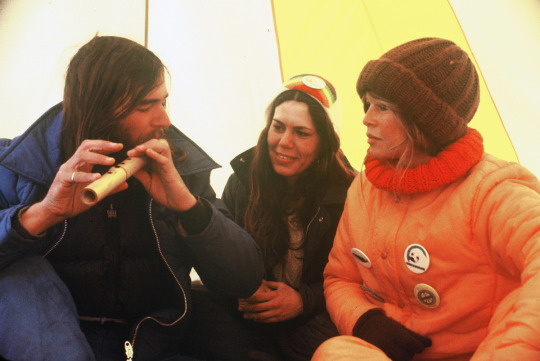
Rainbow Warrior
Back in London, Susi next wanted to disrupt Icelandic whaling. She recruited Denise Bell from Friends of the Earth and set out to find a boat to confront the whalers in the North Atlantic. I sent her a file of photographs from the nuclear, whale, and seal campaigns. Like us in Canada, Susi had no money. She started fundraising, using Michael Chechik’s documentary film of the first two whale voyages, which was aired on the BBC with an introduction by British naturalist David Attenborough. Susi and Denise met Charles Hutchinson from London and Allan Thornton from Canada, and the group opened the first Greenpeace office in the UK at 47 Whitehall Street. Simultaneously, French activist Rémi Parmentier and Canadian David McTaggart opened another office in Paris, where they were protesting French nuclear testing in the South Pacific.
Susi and Denise Bell scoured maritime journals, looking for ships for sale. On the Isle of Dogs, in the Thames Docklands, they found a rusting, diesel-electric, 134-foot trawler that had been converted to a research ship by the Ministry of Agriculture, Fisheries, and Food. The Sir William Hardy was available to the highest bidder. Charles Hutchinson introduced them to the manager at Lloyds of Pall Mall bank. They received a bank loan, secured by the life insurance policies of Hutchinson and Bell. The Department of Trade accepted their bid of £42,725, and they put down a 10 percent deposit, £4,272, on the ship. This was the first ship that Greenpeace actually owned, and Susi sent us photographs of the sad looking trawler that within a decade would become one of the most famous ships of the 20th century.
Newborn, Bell, and an army of volunteers cleaned the ship, stem to stern. Susi recruited her childhood friend Athel von Koettlitz and Australian boyfriend Chris Robinson to tackle the restoration. They clambered down into the pitch-black engine room with a flashlight. The hovel was a rust bucket, and the 800-horsepower engine had not been fired in years. They wiped moisture off gauge glass, tightened loose fittings, and got the two-stroke diesel engine running. Susi and the team removed trawling gear, scraped off rust, painted the ship, and shopped for second-hand parts.
In the fall of 1977, they negotiated with the Ministry to reduce the final price of the Sir William Hardy to £32,500, about £182,000 today. To raise this money, they toured Europe with the documentary, The Voyage to Save the Whales. In the Netherlands, the World Wildlife Fund financed a fundraising campaign. Bob and Bobbi Hunter departed for Amsterdam to accept the money for Greenpeace. On the way, they stopped in London to see the new ship, and there Bob Hunter gave Susi a copy of Warriors of the Rainbow, a book that had inspired Greenpeace in Canada, with a prophecy about how all the people of world — people of the rainbow — would come together to save the Earth from ruin. The crew later agreed to rename the ship Rainbow Warrior. The crew added rainbows to the ship’s deep green hull, a white dove copied from the book cover, and painted Rainbow Warrior at the bow, the vessel’s glorious new name.
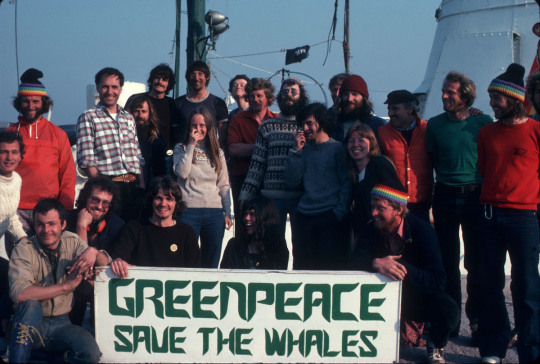
Whales and nuclear waste
Susi saw Greenpeace as an integration of ecology, the Gandhian satyagraha she had learned from her father, Quaker direct action, and a deep respect for Indigenous Earth-informed spirituality. She was naturally inclusive and realised that the hard-edged punks of London appreciated ecology as much as the hippies, peace activists, and affluent conservationists. She recruited nuclear campaigner Peter Wilkinson, who had grown up around the South London docks, and had good relations with the dockworker unions, whom he convinced to “turn a blind eye” to the non-union Greenpeace team working on the ship. Susi built alliances with everyone. “Our gut reactions to injustice are the same,” she told her colleagues.
By January 1978, the Rainbow Warrior was ready for its first ecological campaign, and on 2 May, they slipped down the Thames and into the North Sea. The seasoned crew included skipper Nick Hill; chief mate Jon Castle; Peter Bouquet, a mate off a tanker; cameraman Tony Mariner; and Von Koettlitz assisting Chief engineer Simon Hollander. Devonshire nurse Sally Austin served as medic, Hilari Anderson from New Zealand as cook. Bob Hunter and Fred Easton joined the crew from the Greenpeace Foundation in Canada. Remi Parmentier and David McTaggart joined from the Paris office; and Bell, Hutchinson, Thornton and Susi Newborn form the UK core of the crew. Others came from Holland, Scotland, South Africa, Switzerland, and Australia.
Crowds welcomed the ecologists in Calais, Amsterdam, Hamburg, and Aarhus, Denmark, where Susi and the crew showed films from earlier Greenpeace missions. Greenpeace organisations emerged in some of these cities. Susi understood that to spread the ideas of peace and ecology we needed to not only take action, but also build the movement itself.
The Rainbow Warrior crew confronted Icelandic whalers, then put into Reykjavik to release film to the media. Pete Wilkinson joined the crew in the UK and told Susi he had found evidence that the European nuclear industry was dumping radioactive waste into the Bay of Biscay, off Spain. The crew decided to expose the toxic dumping scheme, and pushed south. They would soon blow the lid off one of Britain’s nastiest secrets.
At Falmouth Bay, Susi and Denise Bell returned to London to issue media releases and handle inquiries. Easton and Mariner travelled north to Sharpness, where the nuclear dumping ship Gem sat in port, loading large drums labelled: RADIOACTIVE WASTE.
Later, off the coast of Spain, the Rainbow Warrior interrupted the dumping. A 600-pound drum dropped from the Gem and flipped a Zodiac, throwing Gijs Thieme into the water, as the film crew captured the event. Later, in London, Susi and the European media teams released the film and photographs and organised a debate with nuclear industry representatives on the BBC. The activists revealed that each year, approximately 80 kilograms of plutonium-239 had been dropped into the Atlantic trench. In a few weeks, the Rainbow Warrior team had opened a new era of scrutiny for the entire European nuclear industry.
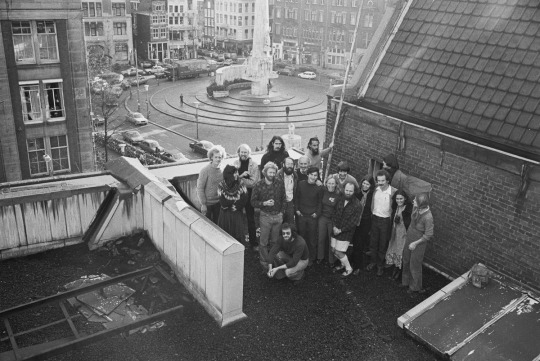
Greenpeace International
For the summer of 1979, Susi and the London activists organised new confrontations with the Icelandic whalers and the nuclear garbage scow Gem. Susi, the alliance builder, offered the Rainbow Warrior to Amnesty International, CND, Greenpeace New Zealand, and to other activists for campaigns. When crews returned from campaigns, Susi later told the New Zealand Dominion Post, “it’s like they’ve been to a war zone. You feel like you’ve gone to some bloody killing field somewhere.” In 2015, she recalled, “I still have injuries from those experiences.”
As Greenpeace became more famous, power struggles naturally arose, and in 1979, Susi fled London to get away from the conflicts. She retreated to the Greek island of Samos, but didn’t rest for long. In Ayios Konstantinos, she heard from fishermen about an annual massacre of Aegean monk seals in the Mediterranean. In her typical fashion, Susi organised “Greenpeace Aegean Sea,” recruited young environmentalist William Johnson, launched a monk seal crusade, and made an alliance with Dr. Keith Ronald from Guelph University in Canada, who brought in the World Wildlife Fund. The ad hoc group successfully ended the marine mammal massacre.
I next met Susi in November 1979, when we gathered in Amsterdam to create an International Greenpeace Council to coordinate the fast-growing organisation. Susi arrived on the Rainbow Warrior with Jon Castle, Tony Mariner, Athel von Koettlitz, Pete Wilkinson, and others from Europe. The council included representatives from Canada, UK, US, France, Denmark, and the Netherlands. New Zealand, Denmark, Australia and Germany joined soon thereafter, and Greenpeace now operates in 55 countries.
Susi was a fearless activist, more interested in the ecological vision of Greenpeace than in organisational manoeuvring or who would have power. During the week in Amsterdam, I met with her frequently, and the talk was always about our next actions and what we might achieve with Greenpeace tactics. Susi was the real deal, an activist to admire and emulate.
Kia ora
Susi moved to the US and received a degree in Human Ecology from the College of the Atlantic in Maine. In 1985, in New Zealand, during a campaign to stop French nuclear tests at Moruroa Atoll in the South Pacific, the French Secret Service bombed the ship Susi had loved and laboured over. The bombing broke her heart. “Not in a month of Sundays,” she said, “would I ever have expected a major European country to blow up a peace boat.”
In 1986, she moved to New Zealand (Aotearoa), where she stayed active in ecology and justice campaigns. In 2003, her Rainbow Warrior memoir A Bonfire in My Mouth was published by HarperCollins.
In New Zealand, in the 1990s, Susi served on the Board of Greenpeace New Zealand. She worked for Oxfam as their climate campaigner, for the NZ Refugee Council, and for the film union. Susi was a poet and a grand storyteller. She loved to talk about her days with Greenpeace and the importance of nonviolent direct action in changing our world for the better.
In the late 1990s, she moved to Waiheke and remained active in campaigns from protecting sensitive ecological regions to supporting Palestinian civil rights. In 2014, Susi helped create a Climate Voter initiative, encouraging New Zealanders to use their vote to make change. The following year, she joined her friend, Greenpeace Aotearoa executive director Bunny McDiarmid, in a march to stop deep sea oil drilling in the region.
In 2022, Susi began treatment for breast cancer. “I know there is something in the world that is creating a giant cancerous tumour,” she said at the time, “that is tearing us apart, commodifying the air we breathe and the water we drink. I also know that this tumour is interspersed with flowers and song birds and the salty waters of the tears we shed.”
Susi Newborn passed away on 31 December 2023, at the age of 73. The Maori community of Waiheke hosted a memorial for her at Piritahi Marae on Waiheke Island, on the tribal lands of the Ngāpuhi and Ngāti Paoa Māori people. Piritahi means, fittingly, “coming together as one.” The community gave her a tangi, a Māori farewell. Friends who worked and sailed and battled with Susi over 50 years, attended and offered fond memories.
“Susi, had a strong sense of injustice,” said McDiarmid, “and never gave up hope it was possible to make change in the world. She believed in the strength of people to make change. She was also really funny, clever and incredibly good company.”
“Susi was brave and fearless,” said her friend Bianca Ranson, “but that was balanced with her kindness and her generosity. Susi showed us how to be fearless and brave and calculating. She taught us how to keep ourselves safe while pushing the line as hard as we could. What she was doing decades ago, if only people had taken that seriously then we’d be in a very different situation now. She was a pillar, a pou, of the island community. What are we supposed to do without her?”
“What I loved in the early Greenpeace years was the feeling that anything could happen anytime, anywhere,” wrote Rainbow Warrior photographer Pierre Gleizes Nicéphore. “On board, life was never dull, and Susi was part of that story from day one.”
“Susi and I have been the best of mates since we met in 77,” said former Rainbow Warrior cook, Hilari Anderson. She called Susi “a feisty sister Warrior.”
I corresponded with Susi and spoke with her by phone many times while she was in New Zealand. She always signed off with “Kia Ora,” a Māori greeting of wellbeing that means “have life.”
Indeed. Kia Ora, dear Susi.
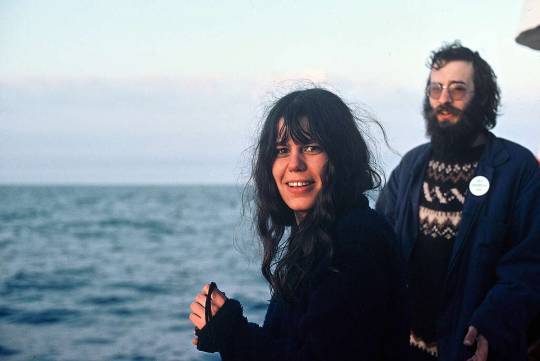
2 notes
·
View notes
Note
Correction about Raidou: The person Raidou saves from the curse is an admiral in the navy who got cursed since the navy was investigating the shady stuff the army was doing. This is a reference to the real-life conflicts between the Japanese army and Japanese navy which is considered one of the most notorious inter-service rivalries in history.
Okay, this one is complicated and I don't have a lot of time so I'm going to give the QUICK and probably useless version since it'll omit lots of details.
But basically, I won't deny what you say is correct but there are some odd things about the "important naval officer" scenario/scene, especially in the Japanese version. Much of my info on this is from a Japanese blog that goes into detail about nationalism in Raidou specifically. A healthy amount of it was summarized for me by @dijeh, who says much of it sounds a bit out there, lol. That said, there's still aspects about it that are conspicuous, but take with a grain of salt.

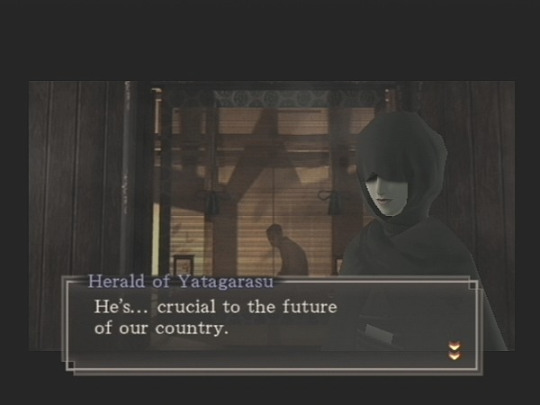
LP of the chapter (Episode 7: The Cursed Detective) here.
The Japanese version of this scene is available here.
If the cursed person were just an admiral, why the very coy, dramatic presentation at the Yatagarasu shrine? They could have easily created a fictional admiral character but instead chose to depict the cursed in silhouette and are talking around his identity despite his stated "crucial" role. This is just my observation.
The blogger emphasizes the following points (repeatedly, apparently, lol):
Atlus could not use Emperor Showa (Hirohito) because of his war crimes, thus they extended the Taisho era to a fictional year, 20; in reality, the Taisho emperor died of pneumonia and the era lasted only 15 years. Taisho was also a pre-war era and there is nostalgia for it.
The Yatagarasu organization is representative of the State Shinto of the period: the three-legged crow Yatagarasu was sent from the heavens to guide the first emperor, Jimmu, of Amaterasu's lineage, to military victory. State Shinto instituted the divine identity of the emperor, and the Yatagarasu organization is old and directly connected to the emperor. It specifically uses Japanese native religious imagery and names, not Buddhism.
The JP constitution says the emperor is the leader of the ground, sea, etc. forces, yet the game only names him the leader of the naval force because it's usually associated with heroic deeds, unlike the army which is associated with war crimes. (Personal anecdote: Japan still seems to be proud of its WWII naval forces and I visited a museum dedicated to the battleship Yamato near Hiroshima. I felt odd being there, since the Yamato was sunk by American bombers; I didn't feel the same way at Hiroshima, probably because its message is for global peace and total nuclear disarmament.)
The writer is also particularly bothered by the fact that you can't refuse to save this cursed person.

Last tidbit is that the god who curses the person is Hitokotonushi, who notably appears to Emperor Yuryaku in the Kojiki, where he says he can proclaim "good fortune in one word, bad fortune in one word," which the game seems to be quoting. This plays into the game's "Kunitsu seeking revenge on the Amatsu" plotline, so why would he curse someone who isn't also directly related to the Amatsu in some way?
35 notes
·
View notes
Note
Hi
As you are probably aware, these are dark days for all the free people, all the people who can appreciate freedom, beauty, knowledge, progress and are struggling to improve themselves and the world. We are witnessing an unprecedented situation, something whose magnitude of importance outweighs everything else since the Second World War. People’s rights are violated, their dreams destroyed, their happiness shattered, their sovereign lands and way of life are imperiled. And yet, it’s not all about this great tragedy, because a bigger one is looming above us all. Connected with the first Chapter of Misery, now a second Chapter opens: of potential War with global consequences.
I want to tell you that you have been brave so far, and able, and willing; and you fight for your beliefs, and you try to change attitudes and social perceptions, and you struggle for equality and rights and acceptance. You have noble aspirations, and you want to see a better future.
This future is now in grave danger from something that could erase everything in minutes. Everyone is aware of the threat of Nuclear Weapons, and so far, the superpowers have been reluctant to use them, even going to the extent of signing treaties of progressive disarmament, up to a degree. For the first time in this generation, this might stop, and also, the nuclear armament is to increase, and placed in various parts of Europe, and the rest of the world. If you care for your friends, your family, your children… and even if you only care for economic benefits and financial interests, a Nuclear War Must Not Happen. Even in the case of a limited exchange of strikes, the radiation will kill thousands, and damage hundreds of thousands. A total war, as everyone knows, is not to anyone’s interests; it is madness. And yet, despite common sense, despite many forecasts by analysts and politicians, this DANGER is before Europe’s door.
If this planet matters to you in any way, if life itself still matters to you, if you Love, if you still desire to live in a world free of such a threat, now is the time to act. Speak to your friends, the local authorities, the politicians, the government everywhere; speak to them in the armed forces, in the police, the emergency services, the hospitals, raise awareness Now, and put pressure to All to Listen. Join your voice to many millions of others; and for those who don’t have a voice, living in a third world country, become their Voice and protest against Nuclear War. This is the closest we have been on the doorstep of annihilation, and if a nuclear exchange starts, it won’t stop until the protocols say so. So it’s important that it Never Starts. The future of this world is in Your Hands.
Thank you for listening.
yuh
7 notes
·
View notes